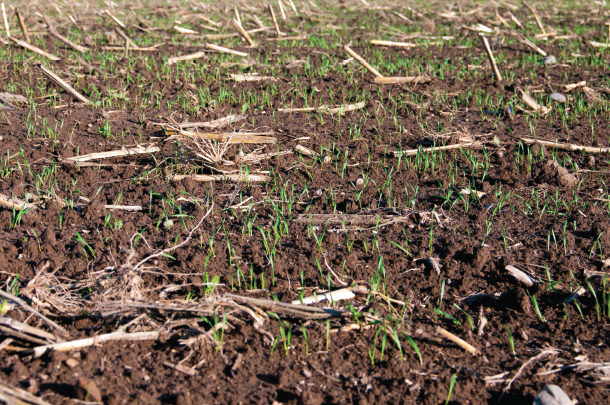This provides a valuable opportunity for producers to plant and feed small-grain cover crops like wheat, rye, triticale, barley and oats. When harvested as silage, small-grain crops provide producers with large quantities of high-quality forage throughout the year. The nutrient composition of commonly fed small-grain silages are in Table 1.
 Usually produced during the fall and spring growing seasons, small-grain crops can improve soil quality and fertility while benefiting the environment. Cover crops are capable of protecting soil from wind and rain erosion and scavenging residual soil nitrogen to reduce nitrate leaching.
Usually produced during the fall and spring growing seasons, small-grain crops can improve soil quality and fertility while benefiting the environment. Cover crops are capable of protecting soil from wind and rain erosion and scavenging residual soil nitrogen to reduce nitrate leaching.
More importantly, harvesting small grains as silage can increase annual forage yield per acre by allowing producers to harvest more forage from the same land base. Although a small-grain harvest requires the additional input of labor, equipment, and seed, the extra silage inventory can ameliorate the effects of forage yield losses incurred earlier in the year.
Recommendations
Alfalfa and corn silages often overshadow small-grain silage. However, if harvested and managed properly, small-grain silages can provide producers with an excellent forage to meet the nutrient demands of milk production. In order to produce the highest-quality silage possible, there are a few important factors that must be taken into consideration.
The first factor is which forage to plant and later feed. Forage quality and yield can vary between small-grain species. However, more variation in performance tends to exist between cultivars within the same forage species than between species themselves. Although climate and soil fertility can directly influence small-grain silage quality and yield, species’ relative maturity is likely the most influential factor.
Rye cultivars are generally the first to mature, followed by wheat and barley. Oats are often the latest to mature. Triticale, a cross between wheat and rye, combines the productivity of wheat with the hardiness of rye and is capable of yielding more than both wheat and rye when harvested for silage. Intercropping small grains with annual legumes like peas has potential to increase forage yield per acre.
Additionally, grain content between forages can vary, and the greater the grain content, the higher the potential feeding value of the silage.
Another important factor to consider is when to harvest small grains for forage. Similar to other crops, as plants mature, yields increase but forage quality decreases. More mature forages have greater concentrations of neutral detergent fiber (NDF), lower concentrations of crude protein (CP) and lower NDF digestibility.
Generally, small-grain yield and quality are optimized at the late-milk stage to soft-dough stage of maturity. At this stage, the milky, high-sugar fluid in the kernel is replaced with digestible starch. At this stage, there is sufficient soluble carbohydrates available for rapid ensiling as well as high forage-energy density. Dry matter (DM) concentrations also increase as small grains mature.
Greater concentrations of DM may inhibit the fermentation process and make it more difficult to properly pack the silage, thereby increasing the risk of yeast and mold growth which can be detrimental to silage quality. Silage that is put up too wet may result in nutrient leaching and could inhibit the acidification process. Therefore, it is recommended silage is harvested at 65 to 70 percent moisture (30 to 35 percent DM). Silage greater than 70 percent moisture will most likely require wilting before it can be packed.
A third factor worth considering is whether or not to utilize silage inoculants when putting up small-grain silage. The addition of bacterial inoculants to silage can enhance the fermentation of sugars to acid in the bag or bunker. Bacterial inoculants generally fall into one of two categories. Homofermentative inoculants almost exclusively produce lactic acid and have been shown to effectively reduce silage pH and improve DM recovery.
Heterofermentative inoculants, which contain bacteria capable of producing both lactic and acetic acid, have been shown to improve silage aerobic stability. Lactobacillus buchneri, the heterofermentative strain most commonly used in silage inoculants, improves aerobic stability by degrading moderate amounts of lactic acid to acetic acid. Acetic acid has antifungal properties that can inhibit the growth of yeasts and molds that may cause spoilage when the silage is exposed to oxygen.
Finally, it is critical that harvested silage is packed and sealed properly in order to produce the highest-quality product possible. Proper packing and sealing minimizes silage exposure to air, which can inhibit fermentation and stimulate the growth of undesirable microorganisms. A theoretical length of cut (TLOC) of 1/4 to 1/2 inches can allow for firm packing, especially if silage is on the drier side. It is also recommended that bunkers or bags be filled as quickly as possible.
Slow filling increases the amount of forage exposed to air and extends the respiratory stage, which can lead to dry matter losses. If small-grain silage is being put up in a pile or bunker silo, the use of multiple tractors will help provide a firmer pack. If silage is being bagged, it is recommended protective covers be applied on the bags to prevent the plastic from being punctured by birds or rocks.
Conclusion
Small-grain silages like wheat, rye, triticale, barley and oats may provide producers with an opportunity to benefit the environment and improve soil quality and fertility while ameliorating the negative effects of forage yield losses incurred earlier in the year. In order to produce as much high-quality silage as possible, producers must take a few important factors into account, including forage species selection, harvest maturity, microbial inoculation and proper silo management.
Once a bag is opened for feedout, it is important to remember that small-grain silage should be tested frequently in order to improve the accuracy of diet formulation and cow productivity. ![]()
PHOTO: Ground cover. Getty Images.
Luiz Ferraretto is an assistant professor of livestock nutrition in the department of animal sciences at University of Florida. Emial Luiz Ferraretto.
Ben Saylor is a graduate research assistant at the University of Florida.











